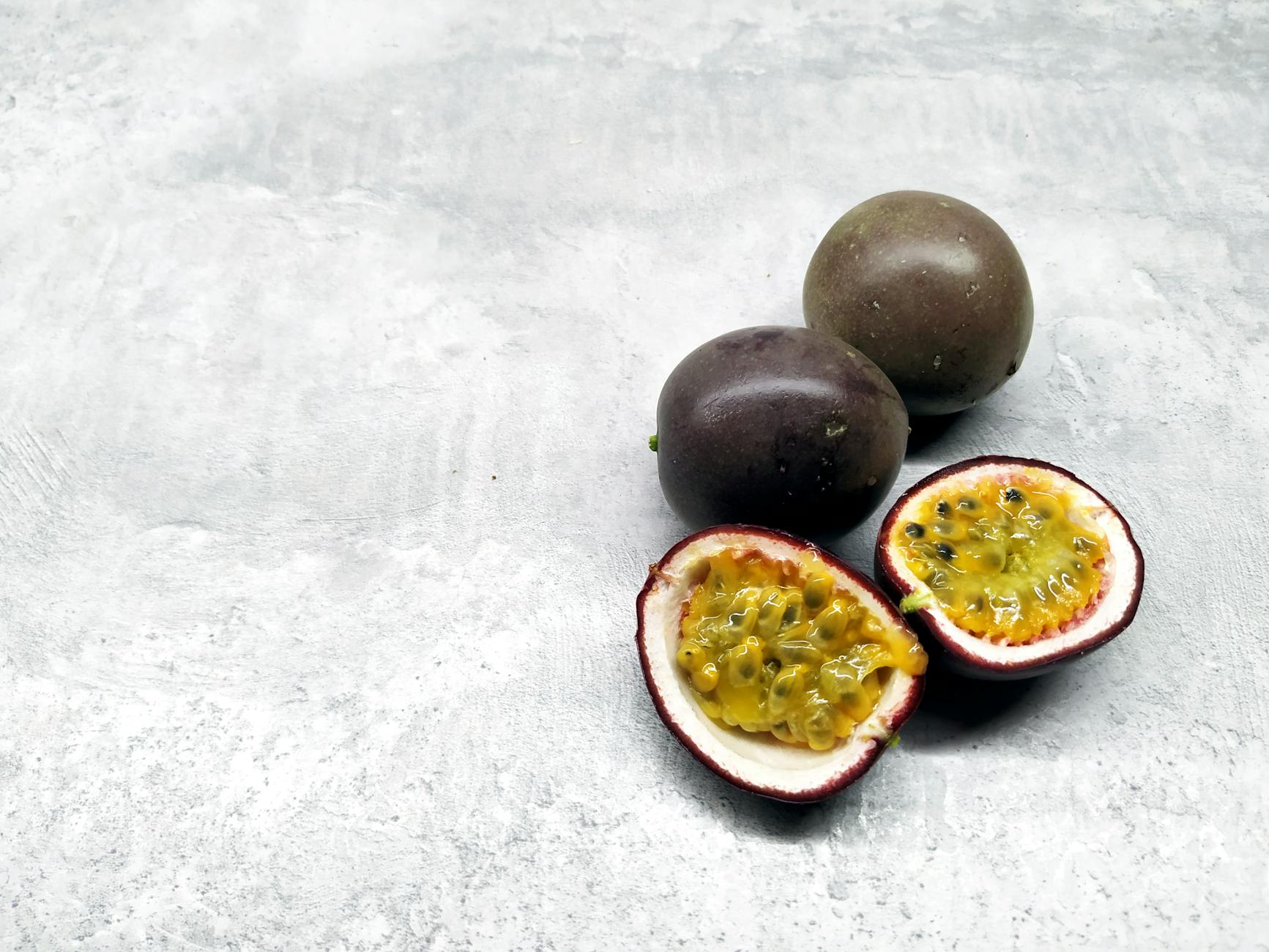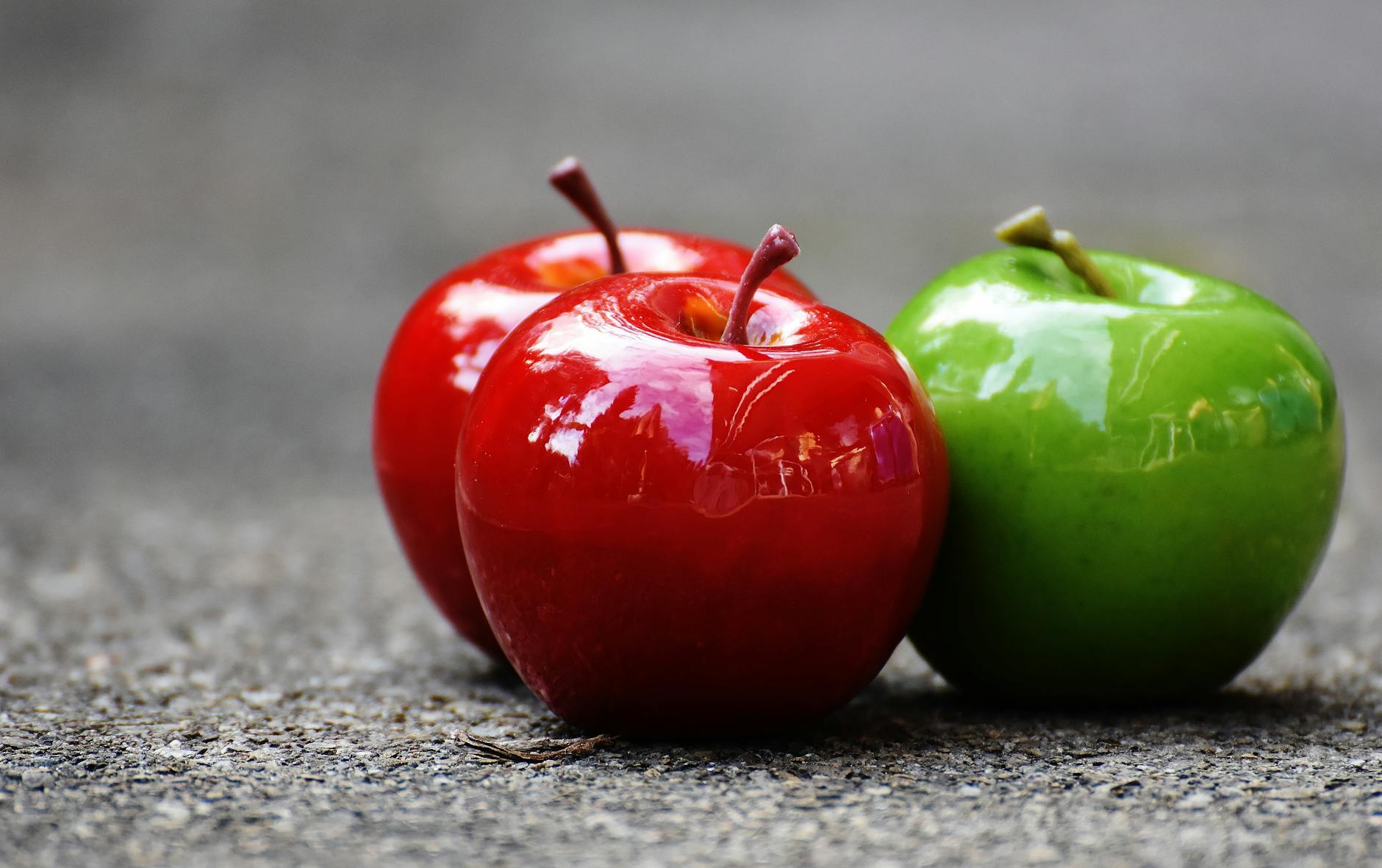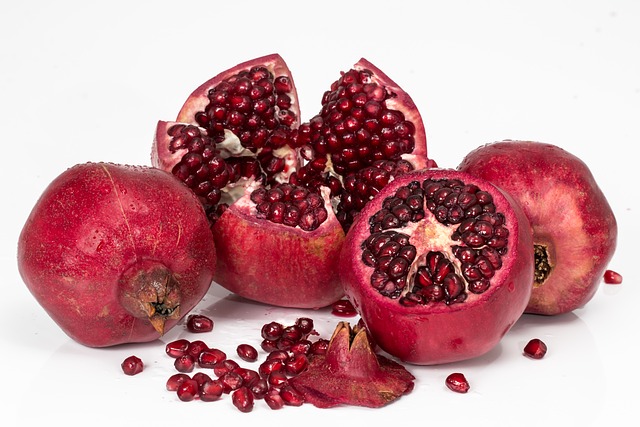Fruits and other plant foods are rich in fiber. The flesh offers soluble fiber, whereas the skin gives insoluble fiber. Including more fruits in your diet is a simple and enjoyable approach to boosting fiber intake.
Fiber is a nondigestible carbohydrate present in plants. There are two types of fiber: soluble and insoluble. Soluble fiber, which forms a thick gel in your colon after digestion, can help you regulate your cholesterol and blood sugar levels. Insoluble fiber increases the size of your stool and promotes regular bowel motions.
Fiber also helps with weight management, immunological health, and lowers the risk of major illnesses like diabetes and heart disease. Despite these benefits, most Americans do not consume the recommended daily fiber intake, which ranges between 21 and 38 grams (g), depending on age and gender.
1. Passionfruit
Passion fruit, which is native to Brazil, has either a round or oval shape and a deep purple rind. Inside the rind is a gelatinous, transparent, and fragrant yellow-orange pulp containing fleshy seeds. Passion fruit is acidic and sour with a slight sweetness, and it is high in carotenoids and sterols, plant chemicals that have antioxidant properties.

Fonseca AMA, Geraldi MV, Junior MRM, Silvestre AJD, & Rocha SM. Purple passion fruit: A complete evaluation of its nutritional value, phytochemical profile, and health consequences. Food Research Int. 2022;160:111665. doi:10.1016/j.foodres.2022.111665.
A 100-gram (g) serving of raw passion fruit contains 10.4 g of fiber or 37% of the Daily Value (DV).
Passion fruit is also high in vitamin C, with a 100 g serving containing 30 milligrams (mg), or 33% of the daily value. Many fruits and vegetables have high levels of vitamin C, an antioxidant that boosts the immune system, protein metabolism, and wound healing.
2. Raspberries
Raspberries are made from a woody shrub native to Europe and come in red, yellow, purple, and black varieties. These petite, luscious fruits are sweet and tangy in flavor—and high in nutrition. One cup of fresh raspberries has 8 grams of fiber or 29% of the DV.
One cup includes 32 mg of vitamin C, which is 35% of the recommended daily value. Berries include a variety of minerals and antioxidants, including polyphenols. According to research, eating berries can improve heart and cognitive health.
3. Blackberries
Blackberries, like raspberries, are made up of tiny, juicy drupelets packed around a central core, resulting in a rough texture. They are grown all over the world and taste tart, sweet, and somewhat bitter.
One cup of raw blackberries has 7.63 grams of fiber or 27% of the DV. This serving also provides 30 mg of vitamin C, which is 33% of the recommended daily value. Blackberries have significant levels of antioxidants in the form of polyphenols, which can help fight inflammation and may lower your risk of diseases such as heart disease and cancer.
4. Blueberries
Blueberries grow throughout North America, Europe, Asia, and Africa. They are small, spherical berries with a rich blue-purple color and a sweet, moderately acidic flavor. One cup of raw blueberries has 3.55 grams of fiber or 13% of the DV.
Blueberries are also high in anthocyanins, which are potent antioxidants found in fruits and vegetables with red, purple, or blue colors. Anthocyanins give these meals their characteristic hue. According to research, eating blueberries or other anthocyanin-rich foods on a regular basis can reduce your risk of heart disease and type 2 diabetes, as well as help with weight management and brain function.
5. Goji Berries
Goji berries are small, brilliant red-orange fruits that appear slightly shriveled. They have a chewy texture and a sweet and acidic flavor. In the United States, they are most commonly found dried or powdered.
Five teaspoons (tbsp) of dried goji berries provide 3.64 g of fiber or 13% of the DV.
Goji berries have the greatest zeaxanthin concentration of any known food source. Zeaxanthin is a carotenoid that appears in red, yellow, and orange fruits and vegetables. Carotenoids can protect the eye from light and oxidative damage, lowering the incidence of age-related macular degeneration (AMD).
6. Pear
Pears are bell-shaped and have smooth, thin skin in green, yellow, red, or brown. The fruit is usually delicious, with crisp or soft flesh. They grow in temperate areas throughout Europe and Asia.
A medium pear has 5.52 grams of fiber or 20% of the DV.
Pears, including the skin, are high in nutrients and healthful phenolic compounds. Some clinical trials have found that pears offer anti-obesity properties.
7. Apple
Apples are grown all over the world and provide a significant amount of phenolic chemicals, such as quercetin, in the Western diet. They are spherical in shape with smooth skin that can be red, green, or yellow. The fruit has a crisp texture and a sweet-tart flavor that varies with the type.
One raw medium golden delicious apple with peel has 4.06 grams of fiber or 14% of the Daily Value.
USDA FoodData Central. Apples are raw, golden, and tasty, with skin.

8. Banana
Bananas originated in Southeast Asia and are farmed near the equator. The fruit is smooth and creamy, with a sweet flavor. Banana peels serve as a natural protective cover, making them an ideal on-the-go snack.
One medium-sized banana contains 3.06 g of fiber or 11% of the Daily Value. It also contains 0.37 mg of vitamin B6, which is 22% of the daily value. Vitamin B6 is a nutrient that affects over 100 biological functions, including metabolism.
9. Orange
Oranges are the most widely produced citrus fruit in the world. It is a cross between the pomelo and mandarin orange. There are different types of oranges, with flavors ranging from sweet to bitter.
One large orange (approximately 3 inches in diameter) contains 4.42 grams of fiber or 16% of the daily requirement. It also contains 98 mg of vitamin C, which is 108% of the recommended daily value.
Oranges also contain antioxidant plant chemicals like carotenoids and flavonoids, which can help protect against inflammation and disease.
10. Tangerines
Tangerines are citrus fruits, sometimes known as mandarin oranges. Technically, they are a larger-shaped mandarin with thinner skin and a slightly brighter orange color. Tangerines are more sour than other mandarins.
One cup of raw tangerine pieces has 3.51 grams of fiber (13% of the daily value). The serving also contains 52 mg of vitamin C, which accounts for 58% of the recommended daily intake.
11. Avocado
This is a fruit that is native to Mexico and Central America and is mostly grown in Mexico. It has a green, pebbled exterior and creamy, pale-green flesh with a nutty, buttery flavor. One cup of diced raw avocado contains 10 g of fiber, which is 38% of the daily value.
Avocados are also high in monounsaturated fats, which are good for your heart, and potassium, which helps manage blood pressure.
12. Kiwi
Kiwifruit is a small, brown, fuzzy fruit with bright green flesh, tiny black seeds, and a sweet, tangy flavor. The texture is delicate and juicy. Although the fruit originated in China, it is currently grown all over the world.
One cup of kiwi has 5.4 grams of fiber, which accounts for 19% of the daily value.
Kiwi is also high in vitamin C and folate, a B vitamin that promotes healthy cell growth and DNA creation. A cup of kiwi contains 134 mg of vitamin C (150% of the DV) and 47 µg of folate (12%).
13. Guava
Guava has rough, greenish-yellow skin and delicious, fragrant, pink or white flesh that contains small, edible seeds. Itstexture varies from crunchy to creamy, depending on maturity. Guava has a tropical sweetness and a tinge of acidity.
A 100-gram serving of raw guava contains 5.4 grams of fiber or 19% of the DV.
Guava, like kiwi, is rich in vitamin C and folate. A 100 g meal includes 228 mg of vitamin C (253% DV) and 49 µg of folate (12% DV).
14. Pomegranate
Pomegranate, which grows in California, Arizona, South Asia, the Mediterranean, and the Middle East, has a bright red color and leathery skin. Inside, it contains hundreds of luscious, sweet, ruby-red arils (fleshy seeds), which are the fruit’s edible components.

A half-cup serving of pomegranate seeds contains 3.48 g of fiber or 12% of the DV.
The fruit also contains valuable plant chemicals, including flavonoids and anthocyanins, which provide antioxidant and anti-inflammatory qualities.
15. Persimmon
Persimmon, a popular fruit in East Asia, has a characteristic form that resembles a tomato and ranges in color from deep orange to reddish-orange. The fruit has a smooth, glossy exterior and a soft, sweet interior.
A single persimmon fruit (weighing around 170 g) contains 6.12 g of fiber or 22% of the DV.
One persimmon fruit contains 0.19 milligrams of copper, which accounts for 21% of the daily value. Copper is a mineral that promotes energy production and supports the nervous and immunological systems. Additionally, persimmons are high in flavonoids, carotenoids, and other useful plant chemicals.
16. Dragonfruit
Dragon fruit, also known as pitaya, grows in a variety of locations, including China, Mexico, Australia and the United States. It’s oval-shaped, with a bright deep pink or yellow outer skin and sweet and sour pink or white flesh studded with tiny black seeds.
One cup of dragon fruit has 5.58 grams of fiber, which is 20% of the daily value.
According to research, consuming dragon fruit can help lower blood sugar, blood pressure, and cholesterol.
17. Prunes
Prunes, or dried plums, are predominantly grown in the United States, France, Argentina, and Chile. The wrinkled, dark purple fruits have a sticky, chewy texture and a sweet, rich flavor.
Five pitted prunes (approximately 50 g) contain 3.37 g of fiber or 12% of the Daily Value. The same meal contains approximately 28 µg of vitamin K or 23% of the DV. This vitamin promotes blood coagulation and bone health.
Prunes can alleviate constipation by increasing stool frequency and consistency. Furthermore, research suggests that consuming 50 g of prunes each day, along with calcium and vitamin D supplements, can assist postmenopausal women in maintaining strong and healthy hip bones.
Tips to Consume More Fiber
Make it a habit to eat fiber-rich fruits with each meal and snack to reach the recommended fiber intake for optimal health. Whole grains, vegetables, legumes such as peas and beans, nuts, and seeds are also good sources of fiber.
Here are some simple methods for incorporating the above fiber rich fruits and other fiber sources into your diet.
- Top a bowl of cereal or oatmeal with fresh raspberries or diced apples.
- Blend a frozen banana, spinach, milk, chia seeds, and honey to make a smoothie.
- Sprinkle pomegranate seeds on a mixed green salad for a blast of color, flavor, and texture.
- Snack on crisp veggies like carrots and cucumber spears with avocado or bean dip.
- Combine dried goji berries and nuts for a tasty and healthful snack.
- Prepare a fruit salad using kiwi, persimmon, berries, lemon juice, honey, and fresh mint leaves.
To Conclude on Fiber Rich Fruits
Fiber is essential for health. It improves intestinal health and may help prevent chronic diseases. Many plant-based foods, particularly fruits, contain rich fiber.
Fruits, including berries, guava, avocados, prunes, oranges, apples, and others, are high in fiber and can help you achieve your daily requirements. Include fiber-rich foods such as vegetables, fruits, legumes, whole grains, seeds, and nuts in your diet to take the full range of health advantages.
